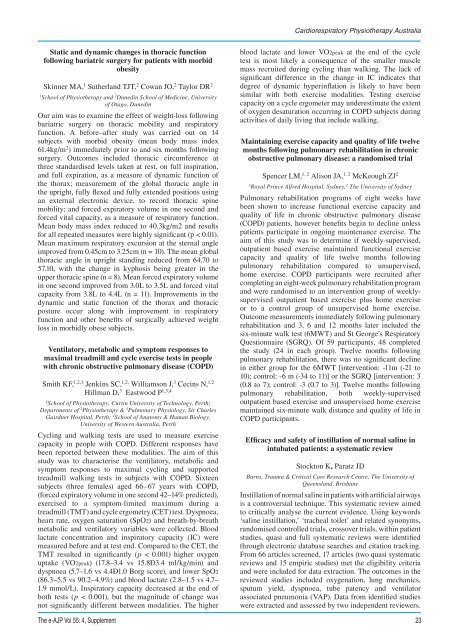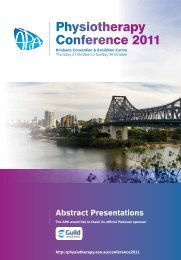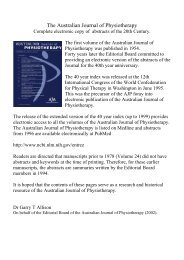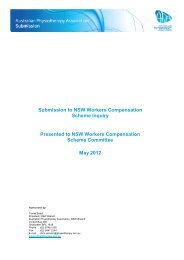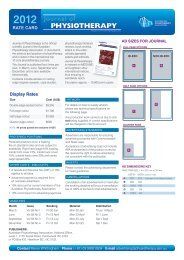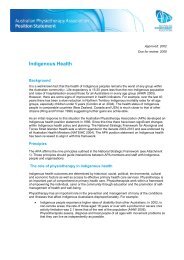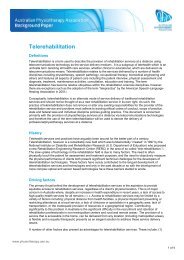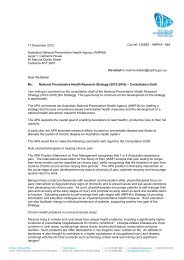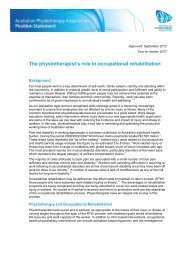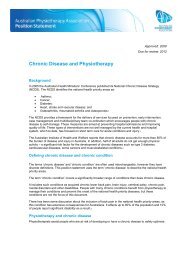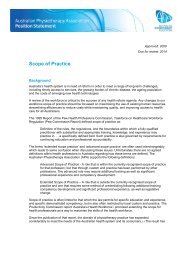2009 APA Conference Week Abstracts - Australian Physiotherapy ...
2009 APA Conference Week Abstracts - Australian Physiotherapy ...
2009 APA Conference Week Abstracts - Australian Physiotherapy ...
You also want an ePaper? Increase the reach of your titles
YUMPU automatically turns print PDFs into web optimized ePapers that Google loves.
Cardiorespiratory <strong>Physiotherapy</strong> Australia<br />
Static and dynamic changes in thoracic function<br />
following bariatric surgery for patients with morbid<br />
obesity<br />
Skinner MA, 1 Sutherland TJT, 2 Cowan JO, 2 Taylor DR 2<br />
1<br />
School of <strong>Physiotherapy</strong> and 2 Dunedin School of Medicine, University<br />
of Otago, Dunedin<br />
Our aim was to examine the effect of weight-loss following<br />
bariatric surgery on thoracic mobility and respiratory<br />
function. A before–after study was carried out on 14<br />
subjects with morbid obesity (mean body mass index<br />
61.4kg/m 2 ) immediately prior to and six months following<br />
surgery. Outcomes included thoracic circumference at<br />
three standardised levels taken at rest, on full inspiration,<br />
and full expiration, as a measure of dynamic function of<br />
the thorax; measurement of the global thoracic angle in<br />
the upright, fully flexed and fully extended positions using<br />
an external electronic device, to record thoracic spine<br />
mobility; and forced expiratory volume in one second and<br />
forced vital capacity, as a measure of respiratory function.<br />
Mean body mass index reduced to 40.3kg/m2 and results<br />
for all repeated measures were highly significant (p < 0.01).<br />
Mean maximum respiratory excursion at the sternal angle<br />
improved from 0.45cm to 3.25cm (n = 10). The mean global<br />
thoracic angle in upright standing reduced from 64.70 to<br />
57.10, with the change in kyphosis being greater in the<br />
upper thoracic spine (n = 8). Mean forced expiratory volume<br />
in one second improved from 3.0L to 3.5L and forced vital<br />
capacity from 3.8L to 4.4L (n = 11). Improvements in the<br />
dynamic and static function of the thorax and thoracic<br />
posture occur along with improvement in respiratory<br />
function and other benefits of surgically achieved weight<br />
loss in morbidly obese subjects.<br />
Ventilatory, metabolic and symptom responses to<br />
maximal treadmill and cycle exercise tests in people<br />
with chronic obstructive pulmonary disease (COPD)<br />
Smith KF, 1,2,3 Jenkins SC, 1,2, Williamson J, 3 Cecins N, 1,2<br />
Hillman D, 3 Eastwood P 1,3,4<br />
1<br />
School of <strong>Physiotherapy</strong>, Curtin University of Technology, Perth;<br />
Departments of 2 <strong>Physiotherapy</strong> & 3 Pulmonary Physiology, Sir Charles<br />
Gairdner Hospital, Perth; 4 School of Anatomy & Human Biology,<br />
University of Western Australia, Perth<br />
Cycling and walking tests are used to measure exercise<br />
capacity in people with COPD. Different responses have<br />
been reported between these modalities. The aim of this<br />
study was to characterise the ventilatory, metabolic and<br />
symptom responses to maximal cycling and supported<br />
treadmill walking tests in subjects with COPD. Sixteen<br />
subjects (three females) aged 66–67 years with COPD,<br />
(forced expiratory volume in one second 42–14% predicted),<br />
exercised to a symptom-limited maximum during a<br />
treadmill (TMT) and cycle ergometry (CET) test. Dyspnoea,<br />
heart rate, oxygen saturation (SpO2) and breath-by-breath<br />
metabolic and ventilatory variables were collected. Blood<br />
lactate concentration and inspiratory capacity (IC) were<br />
measured before and at test end. Compared to the CET, the<br />
TMT resulted in significantly (p < 0.001) higher oxygen<br />
uptake (VO2peak) (17.8–3.4 vs 15.83.4 ml/kg/min) and<br />
dyspnoea (5.7–1.6 vs 4.41.0 Borg score), and lower SpO2<br />
(86.3–5.5 vs 90.2–4.9%) and blood lactate (2.8–1.5 vs 4.7–<br />
1.9 mmol/L). Inspiratory capacity decreased at the end of<br />
both tests (p < 0.001), but the magnitude of change was<br />
not significantly different between modalities. The higher<br />
blood lactate and lower VO2peak at the end of the cycle<br />
test is most likely a consequence of the smaller muscle<br />
mass recruited during cycling than walking. The lack of<br />
significant difference in the change in IC indicates that<br />
degree of dynamic hyperinflation is likely to have been<br />
similar with both exercise modalities. Testing exercise<br />
capacity on a cycle ergometer may underestimate the extent<br />
of oxygen desaturation occurring in COPD subjects during<br />
activities of daily living that include walking.<br />
Maintaining exercise capacity and quality of life twelve<br />
months following pulmonary rehabilitation in chronic<br />
obstructive pulmonary disease: a randomised trial<br />
Spencer LM, 1, 2 Alison JA, 1, 2 McKeough ZJ 2<br />
1<br />
Royal Prince Alfred Hospital, Sydney, 2 The University of Sydney<br />
Pulmonary rehabilitation programs of eight weeks have<br />
been shown to increase functional exercise capacity and<br />
quality of life in chronic obstructive pulmonary disease<br />
(COPD) patients, however benefits begin to decline unless<br />
patients participate in ongoing maintenance exercise. The<br />
aim of this study was to determine if weekly-supervised,<br />
outpatient based exercise maintained functional exercise<br />
capacity and quality of life twelve months following<br />
pulmonary rehabilitation compared to unsupervised,<br />
home exercise. COPD participants were recruited after<br />
completing an eight-week pulmonary rehabilitation program<br />
and were randomised to an intervention group of weeklysupervised<br />
outpatient based exercise plus home exercise<br />
or to a control group of unsupervised home exercise.<br />
Outcome measurements immediately following pulmonary<br />
rehabilitation and 3, 6 and 12 months later included the<br />
six-minute walk test (6MWT) and St George’s Respiratory<br />
Questionnaire (SGRQ). Of 59 participants, 48 completed<br />
the study (24 in each group). Twelve months following<br />
pulmonary rehabilitation, there was no significant decline<br />
in either group for the 6MWT [intervention: -11m (-21 to<br />
10); control: -6 m (-34 to 11)] or the SGRQ [intervention: 3<br />
(0.8 to 7); control: -3 (0.7 to 3)]. Twelve months following<br />
pulmonary rehabilitation, both weekly-supervised<br />
outpatient based exercise and unsupervised home exercise<br />
maintained six-minute walk distance and quality of life in<br />
COPD participants.<br />
Efficacy and safety of instillation of normal saline in<br />
intubated patients: a systematic review<br />
Stockton K, Paratz JD<br />
Burns, Trauma & Critical Care Research Centre, The University of<br />
Queensland, Brisbane<br />
Instillation of normal saline in patients with artificial airways<br />
is a controversial technique. This systematic review aimed<br />
to critically analyse the current evidence. Using keywords<br />
‘saline instillation,’ ‘tracheal toilet’ and related synonyms,<br />
randomised controlled trials, crossover trials, within patient<br />
studies, quasi and full systematic reviews were identified<br />
through electronic database searches and citation tracking.<br />
From 66 articles screened, 17 articles (two quasi systematic<br />
reviews and 15 empiric studies) met the eligibility criteria<br />
and were included for data extraction. The outcomes in the<br />
reviewed studies included oxygenation, lung mechanics,<br />
sputum yield, dyspnoea, tube patency and ventilator<br />
associated pneumonia (VAP). Data from identified studies<br />
were extracted and assessed by two independent reviewers.<br />
The e-AJP Vol 55: 4, Supplement 23


